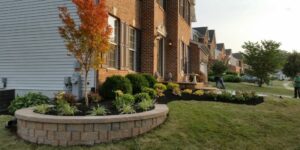The Role of Hardscaping in Maryland Landscape Design: Incorporating Patios, Walkways, and Retaining Walls
In the world of landscape design, hardscaping plays a crucial role in creating functional and aesthetically pleasing outdoor spaces. Whether you’re looking to entertain guests, navigate your garden, or manage sloped terrain, incorporating elements like patios, walkways, and retaining walls can transform your yard into a beautiful and practical haven. By partnering with an expert hardscaping designer in Maryland, you can ensure that these features are integrated seamlessly into your landscape. This blog explores the importance of hardscaping and how a skilled patio designer can help you create an outdoor space that enhances both form and function.
The Importance of Hardscaping in Landscape Design
Hardscaping refers to the non-living elements of a landscape design, including stone, concrete, wood, and other materials used to construct features like patios, walkways, and retaining walls. These elements serve several important functions:
- Structural Support and Soil Management: Retaining walls helps in managing soil and water flow on sloped properties, preventing erosion and providing structural support.
- Defining Spaces: Patios and walkways define outdoor living areas, creating distinct spaces for activities such as dining, lounging, and gardening.
- Aesthetic Appeal: Hardscaping elements add visual interest and texture, complementing the natural beauty of plants and flowers.
- Durability and Low Maintenance: Hardscaping materials are typically durable and require less maintenance than plant-based elements, making them a practical choice for busy homeowners.
Patios: The Heart of Outdoor Living
A well-designed patio can serve as the heart of your outdoor living space, providing a versatile area for relaxation, entertainment, and dining. When working with a patio designer, consider the following aspects:
Material Selection:
- Stone: Natural stone patios offer a timeless and elegant look, with options like flagstone, bluestone, and slate.
- Pavers: Concrete or brick pavers are durable, versatile, and available in various colors and patterns.
- Concrete: Stamped or stained concrete can mimic the appearance of more expensive materials while offering cost-effectiveness and durability.
Design and Layout:
- Shape and Size: The shape and size of your patio should complement your home’s architecture and the scale of your yard.
- Zoning: Create distinct zones within your patio for different activities, such as a dining area, a lounge space, and a fire pit area.
- Incorporate Greenery: Integrate planters, garden beds, or vertical gardens to soften the hardscape and add natural beauty.
Walkways: Guiding and Enhancing Flow
Walkways not only guide movement through your landscape but also enhance its aesthetic appeal. When designing walkways, consider:
Materials:
- Natural Stone: Offers a rustic and organic feel, blending seamlessly with natural surroundings.
- Gravel: Provides a casual and permeable option, ideal for garden paths.
- Brick: Adds a classic and formal touch, suitable for traditional landscapes.
Design Elements:
- Curves and Angles: Incorporate gentle curves to create a sense of discovery and soften the landscape, or use straight lines for a more formal look.
- Lighting: Install pathway lighting to ensure safety and add ambiance during the evening hours.
- Width and Accessibility: Ensure walkways are wide enough for comfortable passage and consider accessibility features for all users.
Retaining Walls: Function and Beauty
Retaining walls is essential for managing sloped terrains, preventing erosion, and creating level areas for planting or recreation. They also add visual interest and structure to your landscape. Key considerations for retaining walls include:
Materials:
- Stone: Natural stone walls offer durability and a timeless aesthetic.
- Concrete: Versatile and strong, concrete can be molded into various shapes and finishes.
- Timber: Provides a rustic look but may require more maintenance over time.
Design Considerations:
- Height and Terracing: Design walls at appropriate heights for safety and consider terracing for steep slopes to create multiple levels and planting areas.
- Drainage: Proper drainage is crucial to prevent water buildup behind the wall, which can lead to structural failure.
- Integration with Landscape: Retaining walls should complement the overall design and blend with other hardscaping and landscaping elements.
Conclusion
Hardscaping is a fundamental component of landscape design, providing both functional and aesthetic benefits. By incorporating patios, walkways, and retaining walls, you can create a cohesive and inviting outdoor space that meets your needs and enhances your property’s value. Collaborating with a hardscaping designer in Maryland ensures that these elements are expertly integrated, while a skilled patio designer can help you create a central hub for outdoor living. Embrace the potential of hardscaping to transform your landscape into a beautiful, functional, and enduring retreat.




